Public asked to join with tribes on June 23
“The snake was moved but kept coming back, just like our people. We will continue to keep coming back.” – Preston Arrowweed, Quechan elder. He believes unusual animal visitations at site are signs from Indian spirits, asking his people to help.
By Miriam Raftery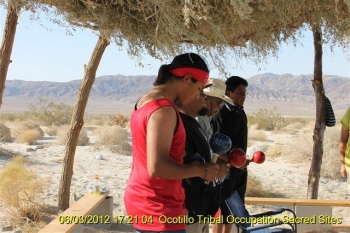
Jim Pelley, Denee ‘Estevane’ Woolley, and Susan Massey also contributed to this report
June 7, 2012 (Ocotillo)—Neither blistering heat nor blowing dust dissuaded Native Americans from at least four tribes from taking part in a five-day occupation in Ocotillo last week.
They came to be with the spirits of their ancestors. They also aim to show that desert devastation occurring with construction of the Ocotillo Express wind facility is wrong and must be stopped.
A mystical element seemed to permeate the site, where tribal members built a ramada of tree branches, willow and arrow weeds to shade them from the scorching sun. After a sidewinder rattlesnake entered the Ramada, it was gently relocated, but returned later in the day.
“The snake was moved, but kept coming back, just like our people. We will continue to keep coming back,” said Preston Arrowweed, a Quechan elder who considers unusual animal visitations at the site to be signs from the Indian spirits.
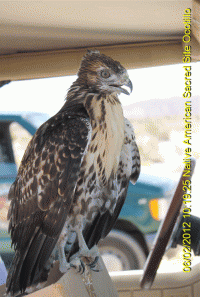 Later, a young hawk appeared in the Ramada site, in essentially the same location where the snake had been found. The young raptor seemed calm and unafraid. Again, this was attributed to be a sign from the Indian spirits. “It is as if they are asking for our help,” Arrowweed told ECM. A wildlife authority was called to assists the young hawk.
Later, a young hawk appeared in the Ramada site, in essentially the same location where the snake had been found. The young raptor seemed calm and unafraid. Again, this was attributed to be a sign from the Indian spirits. “It is as if they are asking for our help,” Arrowweed told ECM. A wildlife authority was called to assists the young hawk.
Vernon Smith, a Quechan elder, explained that the birds and animals feel safe here, though they normally avoid being around people. But as the world around them is crushed beneath the roar of heavy earth-moving equipment, the wildlife here is being displaced—and seems to sense in the Indians a kindly and kindred spirit.
The Indians are determined to halt the bulldozing of lands they have occupied for some 10,000 years. On these lands, specially trained forensic dogs have recently found numerous cremation sites—sites where ashes of hundreds, perhaps thousands of Native Americans lay buried beneath the 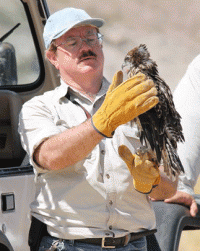 sands.
sands.
Each time a dog alerted at a cremation site, the find was verified by a second specially dog, both trained specifically to locate ancient human remains. The handlers said they were 100 percent positive of the dogs’ accuracy.
The occupation included ceremonies, demonstrations, songs and dancing late into the night and morning hours. At the center of the ramada, an altar was filled with objects that may have been used by the early inhabitants here.
Shortly after sunset on the first night, Smith welcomed everyone and explained parts of the ceremony.
“It began with wo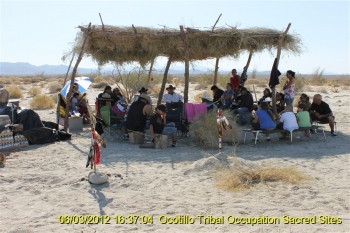 men passing through and around the Ramada with buckets filled with smoking coals of arrow-weed for purification,” Susan Massey told ECM. “Groups of men sang traditional songs, marking the rhythm with gourds and other percussion instruments. Several women formed a line facing the singers and danced.” The singing and dancing would last through the night, as it does for a funeral; at dawn the objects belonging to their ancestors would be burned, a tribal member explained.
men passing through and around the Ramada with buckets filled with smoking coals of arrow-weed for purification,” Susan Massey told ECM. “Groups of men sang traditional songs, marking the rhythm with gourds and other percussion instruments. Several women formed a line facing the singers and danced.” The singing and dancing would last through the night, as it does for a funeral; at dawn the objects belonging to their ancestors would be burned, a tribal member explained.
The living honored the dead at cremation sites, including an ancient spoke wheel geoglyph listed on the National Register of Historic Places. Tribal elders spoke out on the importance of keeping their Native American heritage alive in their hearts and passing along their history, which is written in the rocks and in the 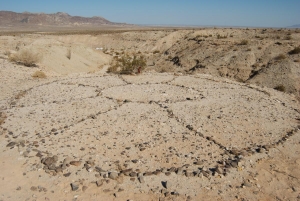 land, to their children.
land, to their children.
In a rare opening to the outside world of ceremonies normally performed in secret, the tribes invited community residents and friends to come hear their stories and help get their message out.
“My family was honored to join with tribal elders, members and friends,” said Denee ‘Estevane’ Woolley, who came with her children on Sunday, June 3. “First we joined a circle and listened to different stories from tribal members regarding the history and the importance of the desert valley to their people. Some stories were about the ancestors’ travels across the valley and the importance of the surrounding mountains, or where certain people originated from.”
Many significant cultural sites that were scattered across the desert were also described, she said. “At day’s end, we walked away from the Ramada with a definite understanding of how important this desert is to Native American culture.”
ECM photographer Jim Pelley, an Ocotillo resident, was also moved by the experience. “What an honor it was to be at this site and listen to Elders and others talk about the reasons they are there and why they need to continue the fight for their sacred land,” he wrote afterwards. “It was a very educational experience that I will never forget.”
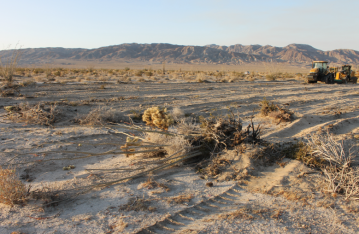 He added, “ I am deeply saddened by the fact that the project is directly threatening the tribal nation’s historical/sacred land and cultural resources…It is beyond belief to think that the decision makers of this project have shown absolutely no respect/consideration for the hundreds of cremation burial sites and other cultural resources through this project area.”
He added, “ I am deeply saddened by the fact that the project is directly threatening the tribal nation’s historical/sacred land and cultural resources…It is beyond belief to think that the decision makers of this project have shown absolutely no respect/consideration for the hundreds of cremation burial sites and other cultural resources through this project area.”
Pelley encouraged others to join with Native Americans. “The message from the tribal members must be carried out to the public to let them know that industrialization of sacred lands is unacceptable,” he concluded. “We must all unite together and endure this fight.”
Winds were high and the Ramada swayed gently, but held up for all five nights of the occupation.
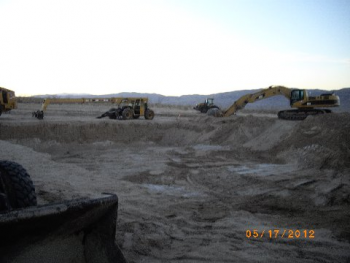 This is only the beginning. The Quechan have filed a lawsuit against the federal government seeking to halt Pattern Energy from completing construction of the project. Viejas, Cocopah and other tribes across the southwest have shown solidarity with Quechan to save these sacred sites on public lands.
This is only the beginning. The Quechan have filed a lawsuit against the federal government seeking to halt Pattern Energy from completing construction of the project. Viejas, Cocopah and other tribes across the southwest have shown solidarity with Quechan to save these sacred sites on public lands.
View a video of Preston Arrowweed of Quechan leading an ancient tribal lands song on the sacred site: http://www.youtube.com/watch?v=2g20lzdGqLY
Several environmental and citizens’ groups have also filed suits, including the Desert Protective Council, Protect Our Communities Foundation, and Backcountry Against Dumps, a trio of San Diego-based enviornmental and community groups. Ocotillo residents now have an attorney preparing for yet more litigation.
The site is vast – 12,400 acres of once-pristine desert. A federal judge has refused Quechan’s request for a temporary restraining order, so the devastation continues on a scale that is both unimaginable and heartbreaking to those who love this place. Gone are the ocotillo cacti that gave the town of Ocotillo its name—bulldozed as horrified residents were denied even the opportunity to try and transplant a few plants to save the towering giants.
Soon, if Pattern Energy has its way, a new forest of over 100 towering wind turbines, each over 450 feet tall with blade sweeps the size of football fields, will occupy this place. Pattern has refused to comment on the Native Americans' objections to the project.
But the Indians are equally determined to stop the desecration.
On Saturday, June 23, tribes invite the public to join with them in a ceremony to grieve for what has been lost and bring public attention to their efforts to save what’s left of the land where their ancestors are buried. They have written to President Barack Obama, imploring him to halt the project and protect their sacred lands.
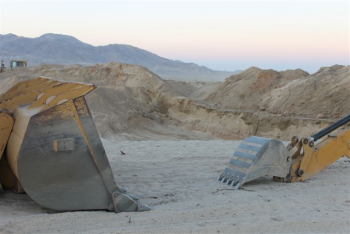 If diplomacy and legal action fails to work, however, there is talk of civil disobedience and a broader occupation with events ranging from concerts, parades and rallies in solidarity with groups as diverse as motorcycle clubs and off-road racers to environmentalists and outdoor enthusiasts.
If diplomacy and legal action fails to work, however, there is talk of civil disobedience and a broader occupation with events ranging from concerts, parades and rallies in solidarity with groups as diverse as motorcycle clubs and off-road racers to environmentalists and outdoor enthusiasts.
“This is about a land grab of our public lands,” Viejas spokesman Robert Scheid said in a strategizing session June 7 in El Centro.
Vast tracts of public property across America, owned by the Bureau of Land Management and U.S. Forest Service, are slated to be handed over to private corporations for development as industrial-scale wind factories—including numerous scenic areas in San Diego’s East County.
Pattern Energy has made some adjustments to the project, agreeing to move locations of some turbines to accommodate tribal concerns. But tribes say that's not enough. A sea of 500-foot-tall turbines blocking the spirit pathway from a sacred geoglyph to nearby mountains deemed the origin of creation in Indians' religion is not acceptable, they believe. Nor is destroying sites used to this day by tribes for religious ceremonies, nor desecreating lands where their ancestors have been buried for thousands of years.
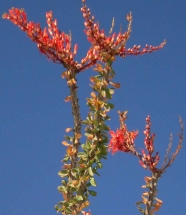 Only a massive public outcry can stop the devastation, insiders believe. The tribes, and those joining with them, do not oppose renewable energy. But they want to know why our government is forcing such a destructive project, instead of supporting rooftop or parking lot solar installations instead.
Only a massive public outcry can stop the devastation, insiders believe. The tribes, and those joining with them, do not oppose renewable energy. But they want to know why our government is forcing such a destructive project, instead of supporting rooftop or parking lot solar installations instead.
“If this is allowed to happen today in Ocotillo,” Scheid warned, “it can happen in a park in your community tomorrow.”







Comments
Thanks, Miriam. I'll be
Thanks, Miriam.
I'll be there;...if for no other reason than to see the desert one last time...